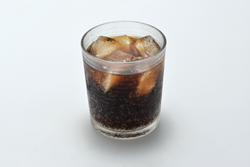
Food Safety Focus (91st Issue, February 2014) – Incident in Focus
4-Methylimidazole (4-MEI) in Cola Drinks
Reported by Ms. Joey KWOK, Scientific Officer,
Risk Assessment Section,
Centre for Food Safety
The issue of 4-methylimidazole (4-MEI), a chemical contaminant, present in cola drinks was once again brought in the limelight in January 2014 when a United States consumer magazine published survey results pointing out that 4-MEI was still widely present in cola drinks available in the US market.
4-MEI and its Occurrence in Foods
Caramel colours are divided into four classes, namely Caramel I, II, III and IV. 4-MEI is a contaminant formed during the manufacturing of Caramel III and IV which involves the interaction of ammonium compounds with carbohydrates under varying conditions of temperature and pressure.
Caramel colours can be used in different foods such as cola drinks, beers, soy sauces, etc. to give the distinctive brown colour. On labels of prepackaged food, caramel colours may be identified with the International Numbering System number "150", whereas the four subclasses may be more specifically identified as "150a", "150b", "150c" and " 150d", respectively.
The public may be exposed to low levels of 4-MEI through the consumption of foods and beverages containing Caramel III and IV. In addition, 4-MEI can also be formed in some foods as a by-product during roasting.

Caramel colours are commonly used in cola drinks to give the distinctive brown colour
Public Health Significance
The safety of 4-MEI in food has raised concern because of its cancer-causing potential. The International Agency for Research on Cancer has evaluated the carcinogenicity of 4-MEI and considered that there was sufficient evidence in experimental animals for the carcinogenicity of 4-MEI and concluded that 4-MEI is " possibly carcinogenic to humans" (i.e. Group 2B).
In the evaluation on caramel colours conducted by the Joint FAO/WHO Expert Committee on Food Additives (JECFA) and more recently again by the European Food Safety Authority, it was considered that the exposure level to 4-MEI that could result from the consumption of foods containing Caramel III and IV did not give rise to concern.
When the issue of 4-MEI present in cola drinks was brought to public attention in March 2012, the highest level of 4-MEI found in cola drinks was 153 micrograms per can of 12 fl. oz. (about 360 mL). Based on our risk assessment, a 60-kg individual would have to consume over 300 cans of that cola drink daily to reach the doses causing cancer in rodents. Referring to the highest level of 4-MEI found in the recent survey (352.5 micrograms of 4-MEI per bottle of 12 fl. oz.), an individual would still have to consume over 130 bottles of the soft drink daily to reach the doses causing cancer in rodents. The US Food and Drug Administration considers that there is no immediate or short-term danger presented by 4-MEI in foods from the use of caramel colours, and does not recommend consumers change their diets because of concerns about 4-MEI.
Regulatory Control
At present, there is no internationally recognised health-based guidance value for 4-MEI nor its maximum permitted levels in foods. Nevertheless, JECFA has specified the maximum levels of 4-MEI in Caramel III and IV in the chemical specifications of caramel colours to indicate good manufacturing practice. In the US, caramel colours may be safely used for colouring foods generally. In Hong Kong, caramel is a permitted colouring matter.
Whilst international authorities have opined that 4-MEI in foods from the use of caramel colours does not give rise to concern, the US State of California has adopted a different approach, and requires businesses to provide a warning if they manufacture or sell products in California that cause exposures to 4-MEI of more than 29 micrograms/day. Such warning does not necessarily mean a product is in violation of any food safety standards. Rather, it serves to enable Californians to make informed decisions.
Key Points to Note
- 4-MEI is a contaminant formed during the manufacturing of Caramel III and IV (150c, 150d).
- Public members may be exposed to low levels of 4-MEI through the consumption of foods prepared with Caramel III and IV.
- Based on the available information, exposure to 4-MEI resulting from the consumption of foods containing Caramel III and IV does not give rise to concern.
Advice to the Trade
- Manufacturers of caramel colours should maintain the levels of 4-MEI as low as technically possible through appropriate process control.
- Food manufacturers should use food colours with the lowest possible level required for the intended colouring function.
- Ensure that all food products for sale comply with local regulations, including food additive and labelling requirements.
Advice to the Public
- Maintain a balanced diet so as to avoid excessive exposure to food additives and contaminants from a small range of food items.
- For concerned individuals, they can read food labels on prepackaged food and look for caramel colours or more specifically Caramel III and IV, or their identification numbers (150, 150c, 150d) to make informed choices.

